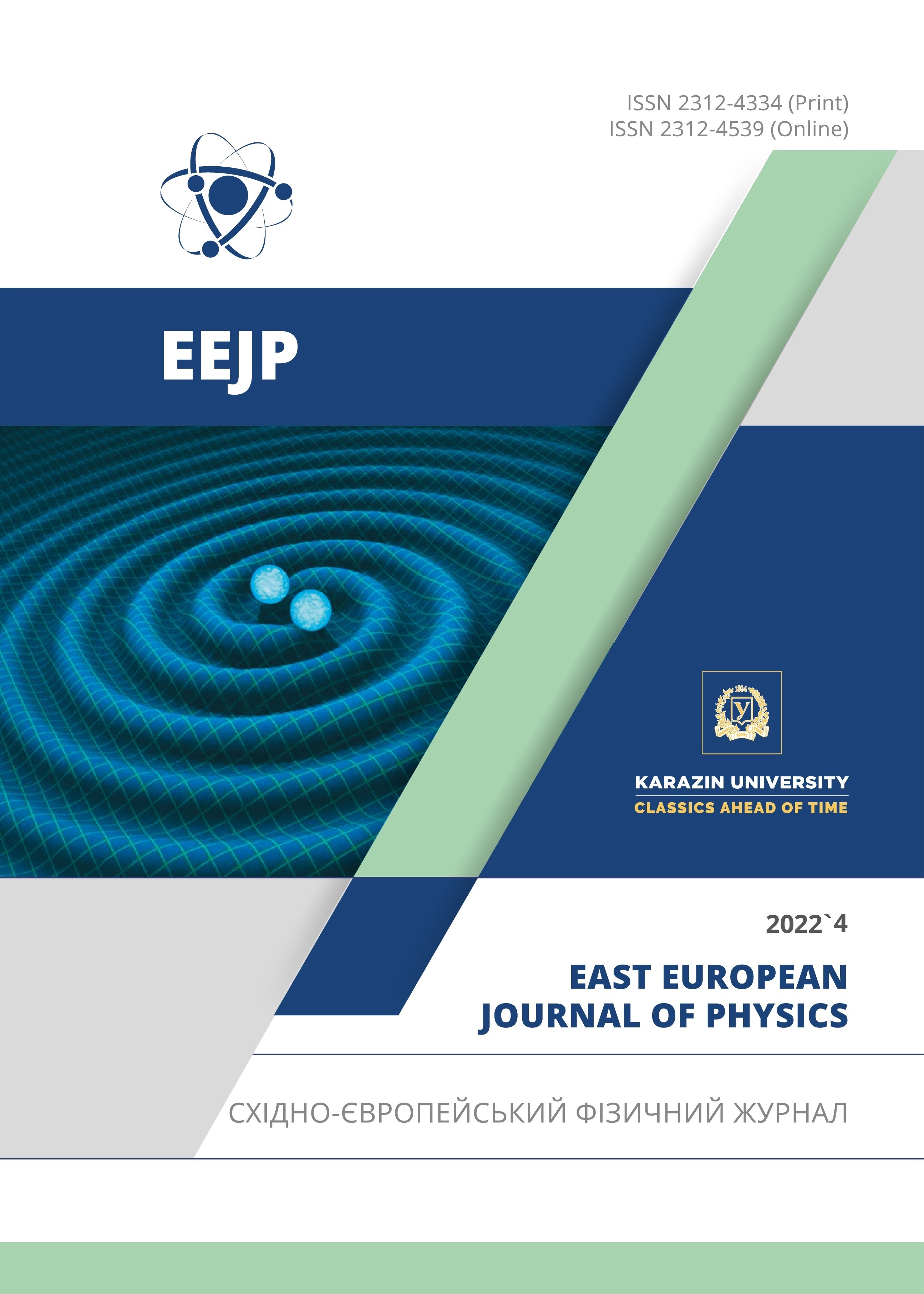A Study of Photoneutron Reactions Using Statistical Analysis
Abstract
The well-known inputs for determining the reaction cross section are nuclear level density (NLD) and -ray strength functions. In this work, effects of -ray strength functions and NLD models on photoneutron reactions of 76,77,78Se isotopes are analyzed by using the latest version of TALYS computer code. For -ray strength functions, macroscopic and microscopic options which are available in the TALYS, are used in the calculations. Kopecky-Uhl and Brink Axel -ray strength function models as macroscopic options, Hartree-Fock BCS tables, Hartree-Fock Bogolyubov tables and Goriely’s hybrid model as microscopic options are preferred. The statistical analysis is carried out to determine the -ray strength function that reproduces the experimental data quite well. And then, calculations of photoneutron cross section are redone by using the determined -ray strength function via the NLD models. The Constant Temperature Model (CTM), Back Shifted Fermi Gas Model (BSFGM) and Generalized Superfluid Model (GSM) are preferred to use in NLD calculations. The predictions are compared with each other and the available experimental data. EXFOR library is used to take all experimental data.
Downloads
References
A. Koning, S. Hilaire, and S. Goriely, TALYS A Nuclear Reaction Program, User Manual, The Netherlans (2022).
M. Herman, et al., EMPIRE, Rivoli Moduler System for Nuclear Reaction Calculations and Nuclear Data Evaluation, User’s Manual, National Nuclear Data Center (2012).
D. Canbula, International Journal of Pure and Applied Sciences, 7, 314 (2021). https://doi.org/10.29132/ijpas.879068
B. Canbula, Süleyman Demirel Üniversitesi Fen Bilimleri Enstitüsü Dergisi 24, 138 (2020). https://doi.org/10.19113/sdufenbed.639828
İ.H. Sarpün, H. Özdoğan, K. Taşdöven, H.A. Yalim, and A. Kaplan, Modern Physics Letters A, 34, 1950210 (2019).
P.V. Cuong, T.D. Thiep, L.T. Anh, T.T. An, B.M. Hue, K.T. Thanh, N.H. Tan, et al, Instruments and Methods in Physics Research Section B: Beam Interactions with Materials and Atoms, 479, 68 (2020). https://doi.org/10.1016/j.nimb.2020.06.011
J. Arends, J. Eyink, A. Hegerath, K. G. Hilger, B. Mecking, G. Nöldeke, and H. Rost, Physics Letters B, 98, 423 (1981). https://doi.org/10.1016/0370-2693(81)90444-5
E. Vagena, and S. Stoulos, Nuclear Physics A, 957, 259 (2017). https://doi.org/10.1016/j.nuclphysa.2016.09.007
F. Kitatani, H. Harada, S. Goko, H. Utsunomiya, H. Akimune, H. Toyokawa, and K. Yamada, Journal of nuclear science and technology, 48, 1017 (2011). https://doi.org/10.1080/18811248.2011.9711787
A.M. Goryachev, Issues of theoretical and nuclear physics, 8, 121 (1982). (in Russian)
D. Canbula, and B. Canbula, Nuclear Physics and Atomic Energy, 23, 5 (2022). https://doi.org/10.15407/jnpae2022.01.005
D. Canbula, International Journal of Pure and Applied Sciences, 8, 173 (2022). https://doi.org/10.29132/ijpas.1081660
D. Canbula, Afyon Kocatepe Üniversitesi Fen Ve Mühendislik Bilimleri Dergisi, 22, 730 (2022). https://doi.org/10.35414/akufemubid.1097069
D. Canbula, Nuclear Instruments and Methods in Physics Research Section B: Beam Interactions with Materials and Atoms, 478, 229 (2020). https://doi.org/10.1016/j.nimb.2020.06.041
B. Canbula, D. Canbula, and H. Babacan, Physical Review C, 91, 044615 (2015). https://doi.org/10.1103/PhysRevC.91.044615
Y. Kucuk, M. B. Yücel, I. Boztosun, T.K. Zholdybayev, B. Canbula, Z. Mukan, and K.M. Ismailov, European Physical Journal A, Hadrons, and nuclei, 58, 97 (2022). https://doi.org/10.1140/epja/s10050-022-00740-8
K. Azhdarli, Y. Kucuk, B. Canbula, T. Zholdybayev, Z. Mukan, B. Emre, B.I. Boztosun, et al, in: Tenth AASPP Workshop on Asian Nuclear Reaction Database Development, (IAEA, Almaty, Kazakhstan, 2019), pp. 53.
B. Canbula, Nuclear Instruments and Methods in Physics Research Section B: Beam Interactions with Materials and Atoms, 391, 73 (2017). https://doi.org/10.1016/j.nimb.2016.11.006
B. Canbula, Celal Bayar University Journal of Science, 13, 445 (2017). https://doi.org/10.18466/cbayarfbe.319917
EXFOR, Brookhaven National Laboratory, National Nuclear Data Center, Database, https://www-nds.iaea.org/exfor/
D.M. Brink, Nuclear Physics, 4, 215 (1957). https://doi.org/10.1016/0029-5582(87)90021-6
P. Axel, Physical Review 126, 671 (1962). https://doi.org/10.1103/PhysRev.126.671
J. Kopecky, and M. Uhl, Physical Review C, 41, 1941 (1990). https://doi.org/10.1103/PhysRevC.41.1941
S. Goriely, S. Hilaire, A.J. Koning, M. Sin, and R. Capote, Physical Review C, 79, 024612 (2009). https://doi.org/10.1103/PhysRevC.79.024612
R. Capote, M. Herman, P. Obložinský, P.G. Young, S. Goriely, T. Belgya, A.V. Ignatyuk, et al, Nuclear Data Sheets, 110, 3107 (2009). https://doi.org/10.1016/j.nds.2009.10.004
H.A. Bethe, Reviews of Modern Physics, 9, 69 (1937). https://doi.org/10.1103/RevModPhys.9.69
A. Gilbert, and A.G.W. Cameron, Canadian Journal of Physics, 43, 1446 (1965). https://doi.org/10.1139/p65-139
W. Dilg, W. Schantl, H. Vonach, and M. Uhl, Nuclear Physics A, 217, 269 (1973). https://doi.org/10.1016/0375-9474(73)90196-6
A.V. Ignatyuk, K.K. Istekov, and G.N. Smirenkin, (Kernforschungszentrum Karlsruhe GmbH, Germany, 1979). https://inis.iaea.org/search/searchsinglerecord.aspx?recordsFor=SingleRecord&RN=11512726
Copyright (c) 2022 Deniz Canbula, Bora Canbula

This work is licensed under a Creative Commons Attribution 4.0 International License.
Authors who publish with this journal agree to the following terms:
- Authors retain copyright and grant the journal right of first publication with the work simultaneously licensed under a Creative Commons Attribution License that allows others to share the work with an acknowledgment of the work's authorship and initial publication in this journal.
- Authors are able to enter into separate, additional contractual arrangements for the non-exclusive distribution of the journal's published version of the work (e.g., post it to an institutional repository or publish it in a book), with an acknowledgment of its initial publication in this journal.
- Authors are permitted and encouraged to post their work online (e.g., in institutional repositories or on their website) prior to and during the submission process, as it can lead to productive exchanges, as well as earlier and greater citation of published work (See The Effect of Open Access).








